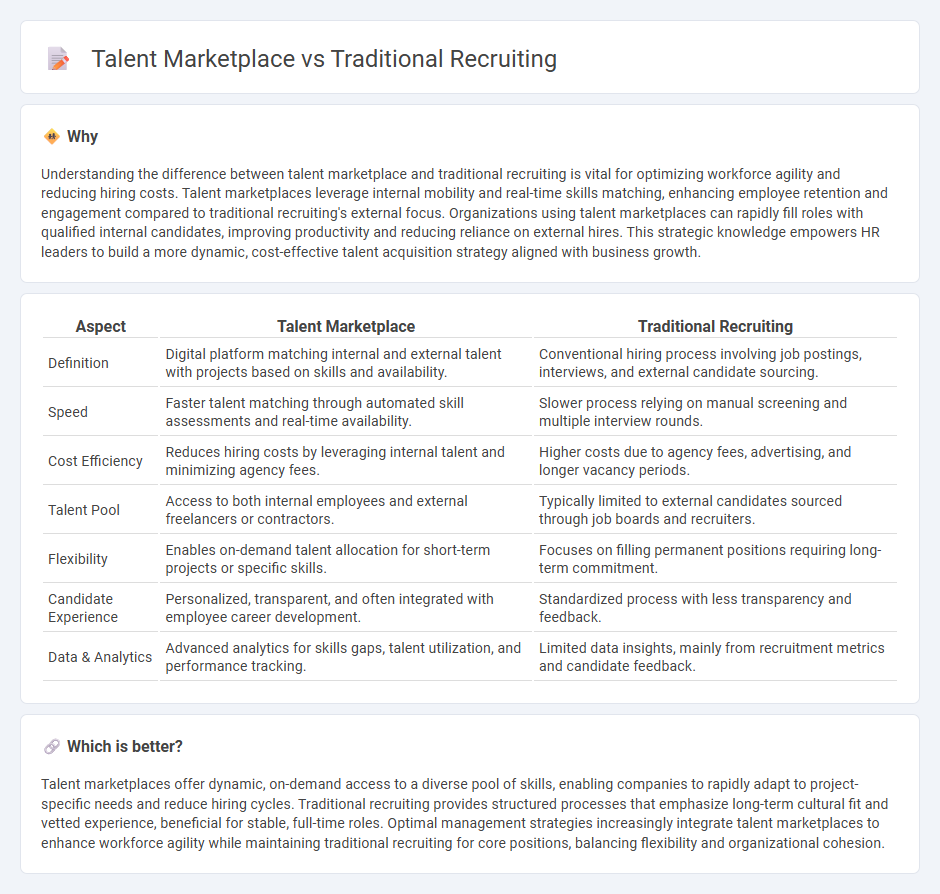
Talent marketplaces leverage internal and external talent pools through AI-driven platforms, streamlining skill matching and accelerating hiring processes. Traditional recruiting relies heavily on manual candidate sourcing, often resulting in longer time-to-fill and limited talent visibility. Discover how adopting a talent marketplace can revolutionize your organization's talent acquisition strategy.
Why it is important
Understanding the difference between talent marketplace and traditional recruiting is vital for optimizing workforce agility and reducing hiring costs. Talent marketplaces leverage internal mobility and real-time skills matching, enhancing employee retention and engagement compared to traditional recruiting's external focus. Organizations using talent marketplaces can rapidly fill roles with qualified internal candidates, improving productivity and reducing reliance on external hires. This strategic knowledge empowers HR leaders to build a more dynamic, cost-effective talent acquisition strategy aligned with business growth.
Comparison Table
| Aspect | Talent Marketplace | Traditional Recruiting |
|---|---|---|
| Definition | Digital platform matching internal and external talent with projects based on skills and availability. | Conventional hiring process involving job postings, interviews, and external candidate sourcing. |
| Speed | Faster talent matching through automated skill assessments and real-time availability. | Slower process relying on manual screening and multiple interview rounds. |
| Cost Efficiency | Reduces hiring costs by leveraging internal talent and minimizing agency fees. | Higher costs due to agency fees, advertising, and longer vacancy periods. |
| Talent Pool | Access to both internal employees and external freelancers or contractors. | Typically limited to external candidates sourced through job boards and recruiters. |
| Flexibility | Enables on-demand talent allocation for short-term projects or specific skills. | Focuses on filling permanent positions requiring long-term commitment. |
| Candidate Experience | Personalized, transparent, and often integrated with employee career development. | Standardized process with less transparency and feedback. |
| Data & Analytics | Advanced analytics for skills gaps, talent utilization, and performance tracking. | Limited data insights, mainly from recruitment metrics and candidate feedback. |
Which is better?
Talent marketplaces offer dynamic, on-demand access to a diverse pool of skills, enabling companies to rapidly adapt to project-specific needs and reduce hiring cycles. Traditional recruiting provides structured processes that emphasize long-term cultural fit and vetted experience, beneficial for stable, full-time roles. Optimal management strategies increasingly integrate talent marketplaces to enhance workforce agility while maintaining traditional recruiting for core positions, balancing flexibility and organizational cohesion.
Connection
Talent marketplaces and traditional recruiting intersect by providing complementary channels for talent acquisition, enabling organizations to access a diverse pool of candidates with varied skills and experiences. Traditional recruiting focuses on long-term, strategic hiring often through structured processes, while talent marketplaces facilitate agile, project-based, or gig work placements through digital platforms. Integrating both approaches enhances workforce flexibility, optimizes hiring efficiency, and addresses evolving business needs in management.
Key Terms
Source and External Links
Traditional vs Modern Recruitment: Which is Best? - Traditional recruiting relies on established practices like in-person interviews and employee referrals, offering personal connections but limited reach and efficiency compared to modern methods.
Traditional Recruitment vs. Modern Recruitment - Historically, traditional recruiting involved classified ads, headhunting, and word of mouth, with recruiters manually sifting resumes and conducting face-to-face interviews.
Traditional vs Modern Recruitment: Which One is Best? - Key traditional methods include newspaper ads, employee referrals, employment agencies, third-party recruiters, in-person interviews, and reference checks.
 dowidth.com
dowidth.com